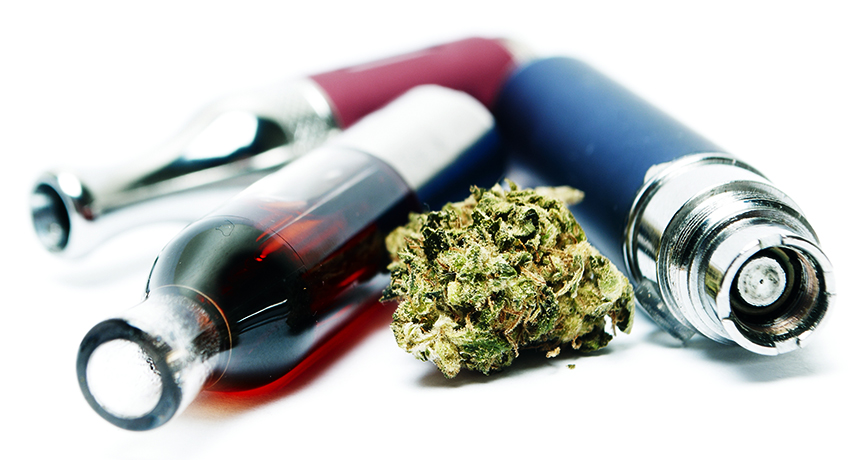The Science of Vaping Marijuana Oil & Concentrates
Vaping and smoking are two popular methods of consuming marijuana. While both involve applying heat to the plant material, the temperature and resulting effects differ significantly. Understanding the science of vaping versus smoking can help users make informed choices about their cannabis consumption.

In this article, we will explore the key differences between vaping and smoking, how they influence the overall experience, the health risks associated with each method, and important considerations for vaping hardware.
Physics & Chemistry: Vaping vs. Smoking
Vaping and smoking both involve heating the marijuana material to transform it into an inhalable aerosol. However, the temperature at which this transformation occurs determines whether it is vaporization or combustion. At lower temperatures, molecules vaporize and change from a solid or liquid state into an aerosol. This process preserves the desired compounds, such as cannabinoids and terpenes, while minimizing the production of potentially harmful byproducts.
On the other hand, smoking involves applying a flame or high heat to marijuana, leading to combustion. This not only causes molecules to vaporize but also converts them into other substances, such as THCA to THC. Combustion can also result in the degradation of compounds, leading to the production of potentially harmful byproducts. When smoking, users inhale a mixture of desired vaporized cannabinoids and terpenes along with these degradation byproducts.
The temperature required for vaporization depends on the specific molecules and the physical substrate. For example, the vaporization temperature for THC varies between dried flower and concentrated oil. In general, vaporization devices for flower use temperatures around 200 degrees Celsius (392 degrees Fahrenheit), while concentrates may require temperatures ranging from 220 to 400 degrees Celsius (752 degrees Fahrenheit) or even higher. However, it is important to note that consuming concentrates using very hot heating elements can involve combustion of the product.
Influence on Experience: Vaping vs. Smoking

The method of consumption, whether vaping or smoking, can significantly influence the overall experience of using marijuana. Vaping at lower temperatures (<300 degrees Celsius) compared to smoking at high temperatures where combustion occurs can result in notable differences.
Firstly, the size of particles inhaled differs between smoke and vapor, affecting their absorption in the lungs. Smoke particles are typically larger than vapor particles, making them less efficient for absorption. Additionally, smoking leads to the loss of THC to the environment through coughing or exhaling large clouds of smoke. As a result, smoking may result in a lower THC intake compared to vaping the same amount of material.
A 2018 study comparing the effects of smoked and vaporized marijuana flower found that vaporization tended to produce higher levels of intoxication when the same amount of material was consumed. This suggests that vaporizers are more efficient in delivering THC to the body compared to traditional smoking methods.
However, it is important to note that individual preferences for the subjective effects may vary. Some consumers report preferring the subjective effects of smoking, even when consuming the same amount of THC. The presence of other compounds in marijuana smoke, such as carbon monoxide, could contribute to these differences. Smoke typically contains higher levels of carbon monoxide, which can lead to mild hypoxia (reduced oxygen delivery to tissues). The mild hypoxia associated with smoking may contribute to the distinct subjective effects experienced by some individuals.
Flavor Differences: Vaping vs. Smoking

Flavor is another aspect that differentiates vaping from smoking. Many of the flavors in cannabis come from terpenes, small aromatic compounds found in the plant. Terpenes vaporize at lower temperatures than cannabinoids, leading to changes in flavor profiles across different vaporization temperatures. Lower temperatures tend to preserve a higher terpene-to-cannabinoid ratio, resulting in more pronounced “terp flavor.”
However, higher temperatures used for vaping can generate harmful thermal degradation byproducts. Experimenting with different temperatures using temperature-adjustable vaporization devices can help users find the desired flavor and smoothness of vapor.
Science Health Risks: Vaping vs. Smoking
When it comes to health risks, vaping marijuana generally carries fewer potential harms compared to smoking. Assuming the marijuana product does not contain harmful additives and the vaping device is properly designed, vaporization produces fewer potentially harmful byproducts compared to combustion (smoking). Smoke, by its nature, contains a greater volume and diversity of potentially harmful compounds that can be inhaled. The composition of tobacco smoke, for example, has been extensively studied and identified to contain over 90 harmful and potentially harmful constituents, including carcinogens responsible for increased cancer risks.
In contrast, vaporization at lower temperatures minimizes the likelihood of inhaling substances beyond those present in the starting material, making it a safer option. However, it is important to note that the long-term health effects of vaping marijuana are still being studied, and more research is needed to fully understand the potential risks.
It is worth mentioning that illicit cannabis vape products should be avoided entirely. These products may contain harmful diluents or additives that can be detrimental to health, as evidenced by the EVALI public health crisis. Illicit market cannabis vape products found to contain vitamin E acetate resulted in several deaths. Therefore, it is crucial to purchase cannabis vape products from reputable sources to ensure safety.
Science of Vaping : Additives & Diluents
In contrast to nicotine products, cannabis oil does not require diluents or synthetic flavor additives for inhalation. Nicotine vape products often contain low percentages of nicotine, requiring diluents to achieve the desired concentration. In contrast, cannabis concentrates, such as distillates, can have high THC concentrations, often exceeding 75% and sometimes reaching 95-99% THC. As a result, cannabis oil does not need the same level of dilution to avoid physical irritation and side effects or to attain psychoactive effects. Diluents in cannabis oil, when used, are typically present in lower concentrations and consist of botanical terpenes native to raw cannabis oil.
Some cannabis oils may contain other diluents, such as PG/VG commonly used in nicotine vape products. However, it is important to note that cannabinoids vaporize at higher temperatures than nicotine, potentially leading to the production of harmful byproducts when vaping cannabis oil containing these diluents. Therefore, it is advisable to choose cannabis oil products without additional diluents to minimize potential risks.
Hardware Considerations for Vaping
The design of vaping hardware plays a crucial role in the science of vaping. One important consideration is the airpath of the cannabis vapor. The airpath should never pass over the internal electronic components of the device, as these components may contain heavy metals or residual solvents used during manufacturing.
Top Shelf Glass Vaporizer Kit
If the airpath comes into contact with internal components, the vapor can pick up these harmful substances. Reusable vaporization devices from reputable brands typically prevent the airpath from passing over internal components. However, disposable vaporization devices may have the airpath in contact with internal components, so it is essential to check the design specifications before use.
Conclusion
Understanding the science of vaping marijuana oil and concentrates can empower users to make informed choices regarding their consumption methods. While vaping generally carries fewer health risks compared to smoking, it is essential to use reputable products and avoid illicit market vape products. Diluents and additives should be carefully considered, with a preference for products that do not require additional substances for inhalation. By understanding the physics, chemistry, and health risks associated with vaping and smoking, users can make informed decisions to enhance their cannabis experience while prioritizing their well-being.

